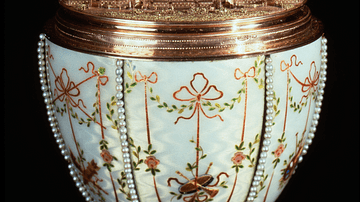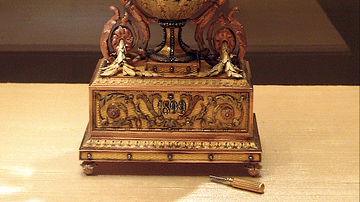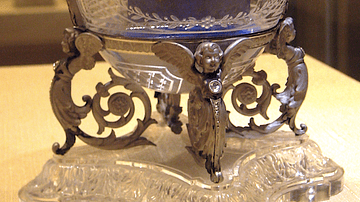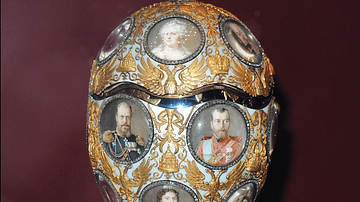Search Images
Browse Content (p. 603)

Image
Gatchina Palace Egg by Fabergé
The 1901 Gatchina Palace Egg by Peter Carl Fabergé (1846-1920). The egg was given by Tsar Nicholas II (r. 1894-1917) to his mother the Empress Dowager Marie Feodorovna. The egg is made of gold and white enamel with painted decoration. The...

Image
Clover Leaf Egg by Fabergé
The 1902 Clover Leaf Egg by Peter Carl Fabergé (1846-1920). The egg was given by Tsar Nicholas II (r. 1894-1917) to his wife Alexandra Feodorovna. The egg is made of gold and green enamel clover leaves studded with rose diamonds and rubies...

Image
Madonna-Lily Clock Egg by Fabergé
The 1899 Madonna-Lily Clock Egg by Peter Carl Fabergé (1846-1920). The egg was given by Tsar Nicholas II (r. 1894-1917) to his wife Alexandra Feodorovna. The egg is made of gold with yellow enamel and set with rose diamonds. The central white...

Image
Alexander III Equestrian Egg by Fabergé
The 1910 Alexander III Equestrian Egg by Peter Carl Fabergé (1846-1920). The egg was given by Tsar Nicholas II (r. 1894-1917) to his mother the Dowager Empress Marie Feodorovna. It commemorates the unveiling of a statue of Tsar Alexander...

Image
Landing of Columbus
Lithograph showing Christopher Columbus (1451-1506) and Native Americans, 1860-1880.
Library of Congress Prints and Photographs Division, Washington, D.C.

Image
Uspensky Cathedral Egg by Fabergé
The 1904 Uspensky Cathedral Egg by Peter Carl Fabergé (1846-1920). The egg was given by Tsar Nicholas II (r. 1894-1917) to his wife Alexandra Feodorovna. It shows the cupola of the Uspensky Cathedral with surrounding Kremlin towers in Moscow...

Image
Romanov Tercentenary Egg by Fabergé
The 1913 Romanov Tercentenary Egg by Peter Carl Fabergé (1846-1920). The egg was given by Tsar Nicholas II (r. 1894-1917) to his wife Alexandra Feodorovna. It commemorated the 300th anniversary of the Romanov ruling dynasty. The egg is made...

Image
Imperial Napoleonic Egg by Fabergé
The 1912 Imperial Napoleonic Egg by Peter Carl Fabergé (1846-1920). The egg was given by Tsar Nicholas II (r. 1894-1917) to his mother the Dowager Empress Marie Feodorovna. It commemorated the 100th anniversary of the Russian wars against...

Image
Imperial Coronation Coach Egg by Fabergé
The 1897 Imperial Coronation Coach Egg by Peter Carl Fabergé (1846-1920). The egg was given by Tsar Nicholas II (r. 1894-1917) to his wife Alexandra Feodorovna. The egg is made of gold and yellow and black enamel. The trellis work has double-headed...

Image
Map of Kenya with Tana River Indicated
A map of Kenya showing the Tana River highlighted in blue.
(By: Internal Map of the World (UTA) - derivative work: Svenskan)